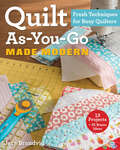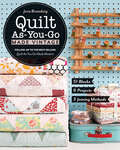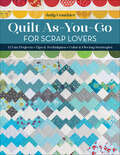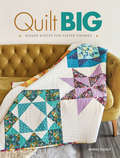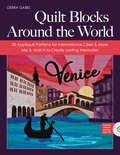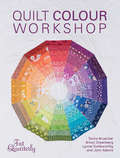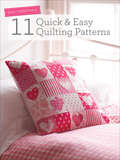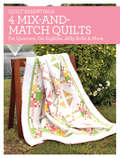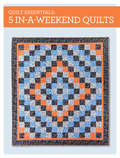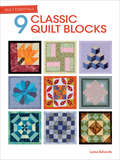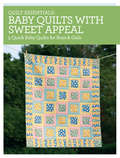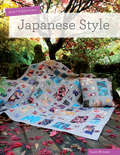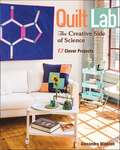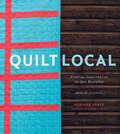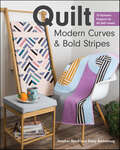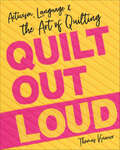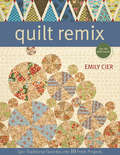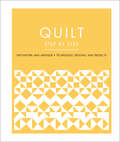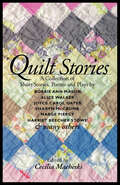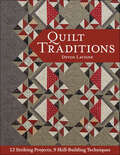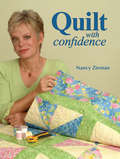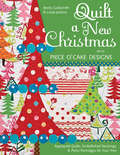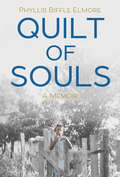- Table View
- List View
Quilt As-You-Go Made Modern: Fresh Techniques for Busy Quilters
by Jera BrandvigLearn to create modern quilts more quickly and easily than ever with this popular method, featuring thirteen projects and twenty-five bonus ideas. Do you believe rules were meant to be broken? If so, this improvisational quilt-as-you-go technique is for you. Instead of dealing with precise paper patterns and cutting measurements, you&’ll learn how to piece fabric onto small, manageable batting blocks. Let your creative juices flow as you quilt directly on the blocks (not the whole quilt!), whether in large abstract zigzags or small structured stitches. After the blocks have been joined, all you need to do is add backing fabric and binding, and—voila—it&’s finished! A modern approach to quilting that&’s fresh, fun, and simpler than it sounds; it will change the way you quilt (for the better) Great for moms or anyone with a busy schedule—these thirteen projects are easy to transport because they make it simple to pick up where you left off Go your own way: This method allows you to use a pattern or improvise, creating a wide variety of design options Save money! Learn how to finish your own quilts without the use of a longarm professional &“Quilting is easier than ever with Jera Brandvig&’s modern spin on the popular quilt-as-you-go technique.&” —Modern Quilts Unlimited&“Quilt-as-you-go (QAYG) is one of those techniques that every quilter is curious about trying, but can be daunting as the process is so different to the traditional process of making a quilt top and then quilting it. . . . The book introduces the technique very thoroughly, so you can clearly understand the difference between traditional piecing and quilting and QAYG. Then there&’s a great selection of gorgeous quilts that are sure to appeal to the modern quilter. A must if you&’ve ever thought about trying QAYG and haven&’t had a clue where to start.&” —Make Modern Magazine
Quilt As-You-Go Made Vintage: 51 Blocks, 9 Projects, 3 Joining Methods
by Jera BrandvigFrom the bestselling author of Quilt As-You-Go Made Modern—learn to create vintage quilts more quickly and easily than ever. Get comfortable with basic piecing and machine quilting - one block at a time! Best-selling author Jera Brandvig is back, this time with a romantic take on her quilt-as-you-go designs. Try your hand at nine projects, including an elegant sampler with fifty-one mix-and-match blocks. For quilt as-you-go enthusiasts, Jera shares three optional joining methods, including her new technique that makes your quilt reversible! No matter how busy your schedule, you can set attainable goals and practice quilting patchwork blocks in small, manageable pieces. · Timeless, classic quilts for busy folks! Easily finish quilts on your home machine with quilt-as-you-go · Learn a new way to quilt-as-you-go that decorates the back of your quilt in pretty patchwork squares · Mix and match fifty-one blocks to assemble a one-of-a-kind quilt!&“Whilst the first book focused on improvisational techniques in a modern style, this one is about using vintage fabrics in classic block designs. There are useful sections on tools and supplies, working with batting, and choosing your fabrics. Each project is laid out in an easy-to-follow fashion that is packed with photos and diagrams. Overall, a well-considered books that is a delight to look through with a warm, encouraging tone of voice.&”—Popular Patchwork
Quilt As-You-Go for Scrap Lovers: 11 Fun Projects; Tips & Techniques; Color & Piecing Strategies
by Judy GauthierScrappy quilt-as-you-go made easy Stack your fabric stash on your worktable –– it's time to create scrap quilts! Turn fabric stashes into unique scrap quilts with Judy Gauthier's quilt-as-you-go method (QAYG). You will find yourself using scraps that you never thought you would use again while discovering several QAYG techniques and projects. The ultimate DIY technique, quilt-as-you-go means you control the whole process from the first stitch to the last. If you're someone who has several WIPs (works in progress), or you need time-saving quilting hacks, this book of fast and easy QAYG is for you. 11 all-new scrappy quilts made using Judy’s quilt-as-you-go method Use every last scrap of fabric! QAYG is the ultimate DIY sewing technique Get a handle on color selection for truly sensational scrappy quilts
Quilt Big: Bigger Blocks for Faster Finishes
by Jemima FlendtBig, bold, impressive designs that sew together quickly and easily! Approaching quilting in a big way, Quilt Big takes the inherent beauty found in single block patterns and creates big, bold quilts, quickly and easily. Whether you're simply short on time or intimidated by complex quilts, Quilt Big will show you how super-sizing your blocks make for faster finishes and so much more. In this block book and design resource, you'll find: 22 BIG blocks to show off your favorite fabrics in fantastic ways.Step-by-step guide to scaling traditional blocks to oversized designs.17 quilt designs featuring bold, super-sized blocks. Plus, these 15", 18", and 24" blocks are interchangeable for one-of-a-kind finished projects!No CD required! Block patterns have been designed in a way that no specially sized templates are needed.If you're new to quilting, there's no better way to learn than on a grand scale. And, for the experienced quilter, large block pieces are a fabric-friendly way to feature your favorite designer collections. Super-size your love of quilting with Quilt Big!
Quilt Blocks Around the World: 50 Appliqué Patterns for International Cities & More; Mix & Match to Create Lasting Memories
by Debra GabelThe author of Quilt Blocks Across America journeys to destinations beyond our borders to bring you new inspiration for travel-themed projects!Debra Gabel’s new collection features fifty all-new 6” square appliqué patterns for exciting locales like Tokyo, Sydney, and Venice, plus general travel-themed designs perfect for any kind of appliqué. An inspiring gallery of the quilt blocks “in action” gives you plenty of ideas for sewing something special to commemorate your travels . . . real or imagined!
Quilt Colour Workshop
by John Adams Brioni Greenberg Tacha Bruecher Lynne GoldsworthyWhat makes a brilliant color combination? An inspiring, idea-filled guide to color theory and how to use it in your quilting projects!This useful guide shares the secrets of successfully using color in your quilting. Discover more about color theory and how to use it in the context of quilting, then apply this theory to practical projects, from quilts and cushions, to wall hangings, table runners and bags. Featuring six color-themed sections with block ideas for every color theory combination, it offers plenty of inspiration for you to create colorful projects!Contributing members of the quilting and sewing e-zine team at Fat Quarterly include Brioni Greenberg, John Adams, Tacha Bruecher and Lynne Goldsworthy.
Quilt Essentials - 11 Quick & Easy Quilting Patterns (Quilt Essentials)
by Various ContributorsA collection of quick and easy quilting projects including designs by authors such as Lin Clemens (The Quilter's Bible), Marion Elliot and Tacha Bruecher from Fat Quarterly. The projects include home decoration notions such as hanging hearts, quilted oven gloves, table mats and cushions. Every project is quick and easy to do even if you've never quilted before. Choose from hand or machine quilted projects and make fabulous gifts for friends and family.
Quilt Essentials - 4 Mix-and-Match Quilts: Fat Quarters, Fat Eighths, Jelly Rolls & More (Quilt Essentials)
by Debra Fehr GreenwayCombine your favorite pre-cuts to make gorgeous quilts! 4 unique quilt patterns that use a variety of pre-cut fabrics. Includes optional fat-quarter cutting instructions for each quilt. Clear diagrams and detailed instructions make sewing easy.
Quilt Essentials - 5 In-a-Weekend Quilts (Quilt Essentials)
by Karen SnyderUse big prints to make quick quilts! 5 quilt patterns that can be pieced in a weekend Tips for working with a variety of large-print fabrics Quilts range in size from twin-size up to queen
Quilt Essentials - 9 Classic Quilt Blocks: 9 Classic Quilt Blocks (Quilt Essentials)
by Lynne EdwardsA collection of classic sampler quilt block patterns from quilting expert, Lynne Edwards. Features step instructions for creating 9 classic quilting blocks which can be quilted as you go. Includes techniques for finishing, quilting and how to turn them into a sampler quilt or wall hanging. Choose from classic quilt blocks including Rail Fence, Log Cabin, Dresden Plate and Maple Leaf. A great introduction to the world of quilt block piecing.
Quilt Essentials - Baby Quilts with Sweet Appeal: 5 Quick Baby Quilts for Boys & Girls (Quilt Essentials)
by Darlene ZimmermanWrap your bundle of joy in a keepsake quilt! Includes 5 quilts that are suitable for both boys and girls. Cute and simple, these projects are easy enough for beginning quilters. Clear diagrams and detailed instructions make sewing a snap!
Quilt Essentials - Japanese Style (Quilt Essentials)
by Susan BriscoeA collection of Japanese style quilting projects by Susan Briscoe which really captures the essence of Japanese quilting style. Includes step instructions for creating Japanese style quilting projects including throws, cushions and quilts. The projects feature traditional Japanese techniques, designs and fabrics.
Quilt Giving: 19 Simple Quilt Patterns to Make and Give
by Deborah FisherEnjoy the simple gift of quilting!Creating a quilt is always a gift--in finding the time to enjoy your hobby, and in giving away your finished piece. In the pages of Quilt Giving, you'll find nineteen quilts that make perfect presents for yourself or someone else.The quilt patterns in this book embrace beautiful color and sewing simplicity. You can take your time to enjoy the process and still have a quilt ready for your next baby shower or winter weekend curled up on the sofa! You'll also expand your sewing skills as you experiment with the big block conventions found in Twinkle, Map and Bloom; use easy corner triangles for simple detail in Gem, Summer and Sprinkle; or cast tradition aside and use a vertical or horizontal grid in Path, Garden and City.Treat yourself to the gift of Quilt Giving!
Quilt Improv: Incredible Modern Quilts from Everyday Inspirations
by Lucie SummersLearn how to create twelve stunning contemporary quilts and develop your own designs using improvisational methods.Take inspiration from simple objects to create twelve beautiful, contemporary quilt blocks. Create original quilts from each block design and adapt them to your own style. Learn how to interpret print, pattern and shapes into unique quilting ideas and experiment with a range of innovative techniques for impressive, professional results. Inside you’ll find techniques such as square piecing, basket weave, half-square triangles, chevrons, quarter circles and portholes.So, if you love fabric and color, take a step into the world of improv quilting.
Quilt Lab: The Creative Side of Science
by Alexandra WinstonDiscover the art and science of quilting • Geek chic! 12 science-inspired quilt designs to ignite your intellect and imagination • Designs so appealing and pretty, even if you don’t have an interest in science, you’ll love them! • Easy-to-use charts eliminate challenging mathematical pattern problems A quilting book like no other, Quilt Lab The Creative Side of Science is as cerebral as it is artistic. Author and self-proclaimed geek, Alexandra Winston, transforms various scientific disciplines into vibrant quilt designs. Extrapolating from ideas such as states of matter and calculus, each of the 9 quilts and 3 smaller projects has a story, lesson, and idea that exemplify its science-inspired design. The author also illustrates the simple "scientific process" of quilting with step-by-step instructions, diagrams, and various hypotheses for customization. This mind-expanding book will encourage you to find inspiration in unusual places and may even teach you a thing or two!
Quilt Local: Finding Inspiration in the Everyday (with 40 Projects)
by Heather JonesThe renowned Ohio quilt artist draws on places and objects in her daily life to craft beautiful modern quilts, encouraging your own creative journey.For Heather Jones, inspiration can be anywhere. For her debut book, Quilt Local, she designed a collection of twenty quilts, each inspired by objects and places close to home—country roads, cityscapes, street signs—the landscape of her existence. Then, in a fascinating exercise in color theory and design play, she reworked each one in a second palette to show what a striking difference just a few basic changes can make. Pattern by pattern, Jones takes readers behind the scenes of her process, sharing photographs of her sources of inspiration, sketchbook pages, and the finished quilts. In addition, she offers an accessible lesson in color theory as it applies to quiltmaking.“Jones, founder of the Cincinnati Modern Quilt Guild, translates architecture into quilt patterns that have ‘a strong visual component’ . . . The simplicity of her designs is well suited for beginners, while the modern aesthetic will attract more experienced quilters.” —Publishers Weekly“The author takes quilters inside her studio for a firsthand look at her process for designing and piecing . . . Modern quilters who enjoy a minimalist style are likely familiar with Jones’s work and will appreciate the insights into her process. The presentation is reminiscent of Denyse Schmidt’s Modern Quilts, Traditional Inspiration.” —Library Journal
Quilt Modern Curves & Bold Stripes: 15 Dynamic Projects for All Skill Levels
by Heather Black Daisy AschehougSew fifteen inspired designs with strong lines and quilted curves! Laced with retro-inspired circles and bold stripes, these modern quilts leave an unforgettable impression. Piecing circles, half circles, and quarter circles is easier than you think, and the authors will teach you to add movement and depth two ways—through easy strip sets or stripe-printed fabric. These aren’t your typical Drunkard’s Path quilts, but distinctive quilts for adventurous quilters! With block-based patterns, some improvisational piecing, and designs ranging from beginner-friendly to complex, there’s something for everyone. Move beyond common circle-quilt designs to tackle curved piecing with ease Add stripes to curved piecing and use color to add depth for a simple way to make complex quilts Piece block-based layouts and improv designs ranging from simple to advanced
Quilt Out Loud: Activism, Language & the Art of Quilting
by Thomas KnauerExplore language through quilting How do letters, numbers, words, and sentences change when used on a quilt rather than a screen or piece of paper? Statement quilts are an emerging trend within the modern quilt movement. Quilt artist Thomas Knauer’s quilts follow the craftivism movement and emphasize social justice issues. From the most serious to whimsical, Quilt Out Loud teaches techniques for making text a part of the readers’ quilts. Each chapter focuses on a particular technique, such as raw-edge applique or piecing in Morse code, and explores its conceptual implications. Craftivism is a rising trend where quilters are using text on quilts to make a statement and take part in social movements Explore methods of effectively incorporating language and data on quilts, whether profound or playful Learn how to use applique, quilted text, binary numbers, morse code, and more for self-expression
Quilt Remix: Spin Traditional Favorites into 10 Fresh Projects
by Emily CierA quilter’s guide to updating the classics—with new settings and colorways for Log Cabin, Irish Chain, and more.The ten patterns in this collection feature surprising contemporary twists on traditional quilts. Progressing through gradually more challenging projects, you can use basic piecing and applique techniques to update Log Cabin, Nine-Patch, Irish Chain, Flying Geese, Ohio Star, Dresden Plate, Pinwheel, and more. Combine the best of past and present with these creative quilt designs made with fresh, fun fabrics that add a special and unexpected touch to any decor.
Quilt Step by Step: Patchwork and Appliqué - Techniques, Designs, and Projects
by DKA complete introduction to quilting, patchwork and appliqué, boasting 15 exciting projects to get you started, as well as covering the materials and techniques needed.Easy-to-use and fully illustrated, this craft book is ideal for quilting beginners, as well as more experienced quilters looking to build on their skills and refresh their techniques.A crafters&’ heaven awaits inside this informative quilting book: • A visual catalog of all the tools and materials needed, including information on types of fabrics, sizes, measurements, and design principles • Step-by-step full-color photographs accompanied by instructions for each stitch and technique, with integrated annotation • A gallery of modern patchwork block designs • 15 easy, inspirational projects that draw on the skills covered • An updated, fresh and modern design Quilting, like most other crafts, has been shown to enhance wellbeing, reduce stress and anxiety, and boost self-esteem. It can even improve physical and cognitive skills and social awareness. Everything you need to master quilting, patchwork and appliqué, make beautiful gifts and items for your home, lies within these pages. Discover the essential quilting tools and materials you need to get started. Then master the key techniques and stitches with simple step-by-step photography and explanations, including using traditional and modern patchwork block designs. Then comes the fun part. Design and stitch your own unique quilts and other quilting projects at home drawing from the 15 fabulous projects included, from bags and toys to cushions and quilt designs — you&’ll learn everything you need to know to create unique gifts and treasured keepsakes from the comfort of home.Can&’t get enough of crafting? Try Crochet Step by Step, Sew Step by Step or Dressmaking Step by Step next!
Quilt Stories: A Collection of Short Stories, Poems and Plays
by Harriet Beecher Stowe Alice Walker Joyce Carol Oates Marge Piercy Bobbie Ann Mason Sharyn McCrumbLiterary works honoring the role of women and quilting in history—from Harriet Beecher Stowe, Joyce Carol Oates, Alice Walker, Sharyn McCrumb, and others.This collection of stories, plays, poems, and songs featuring the making of quilts—written from 1845 to the present, mainly by American women—documents women’s literary history. Featuring the work of Bobbie Ann Mason, Joyce Carol Oates, Alice Walker, Sharyn McCrumb, Harriet Beecher Stowe, Marge Piercy, Adrienne Rich, and many others, Quilt Stories is a colorful literary album of stories, poems, and plays that celebrate quilting as a pattern in women’s history. These stories—grouped under the themes of memory, courtship, struggle, mystery, and wisdom—reflect the importance of quilting in the lives of American women, not only as a practical craft and a creative outlet, but also as an integral part of the social community.“The 28 works included in Quilt Stories restore to women a part of their history and their sense of community, an important service in a present time in which quilting has perhaps become a more private and individual art, though it still serves widely as a medium for social exchange and cooperative endeavor.” —Appalachian Quarterly“Macheski has pieced together a variety of literary fabrics into a unique design which represents women’s struggle for identity in a masculine world.” —Benton, Arkansas Courier“Each writing shares a glimpse of what quilting means to those people who practice the art and how it helps us to see, remember, learn, know and express our feelings.” —Quilt World“An innovative approach to writing the history of women.” —Northwest Ohio Quarterly
Quilt Traditions: 12 Striking Projects, 9 Skill-Building Techniques
by Devon LavigneBehind every great quilt is a greater story Sew a slice of life with 12 traditional quilts that prove to be more than just patterns, but storytellers. Each quilt is inspired by life events that everyone can appreciate. Bold blocks shimmer in their use of color, value, and repetition for handsome quilts with personality to boot. Repeated blocks will stretch your skills beyond the basics, inviting you to perfect techniques such as strip piecing, half-square triangles, working with templates, paper piecing, machine appliqué, and sewing set-in seams and curves in a way that's easy to understand. • Repeat-block quilt projects inspired by heartwarming stories you can relate to • Move beyond standard blocks with strip sets, templates, set-in seams, curves, paper piecing, and appliqué • Personalize each quilt with your own memories
Quilt With Confidence
by Nancy ZiemanThe inspiring and encouraging tone of this book will make you feel like you've been quilting your entire life! From the nation's favorite sewing teacher comes tips and step-by-step instruction for getting started quilting, from selecting tools, to rotary cutting techniques and edge-jointed seaming, you get it all!
Quilt a New Christmas with Piece O'Cake Designs: Appliquéd Quilts, Embellished Stockings & Perky Partridges for Your Tree
by Becky Goldsmith Linda JenkinsThe bestselling design teams delivers “a fresh take on holiday colors and fun patterns for Christmas stockings, lap quilts, and wall hangings” (The Applique Society Newsletter).Piece O’ Cake Designs fills your home with the Christmas spirit all year round! Half of these new designs give the holiday season a whimsical twist with unexpected fabrics and colors, and the other half are versatile and beautiful quilts that you can use even after the rest of your holiday decorations are packed away.Projects include:Christmas in the ParkThe All Wonderful Red & Green QuiltCaribbean ChristmasCircular MomentumA Treat Before Takeoff!The Stockings Were Hung by the Chimney with CarePerky Partridge Pincushion/Ornament“Use the included full-size applique templates to create Christmas stockings, lap quilts, and wall hangings in the distinctive fresh and happy Piece O’ Cake style. Several of the quilt projects can be adapted for year-round use if made in different fabrics.” —American Quilter
Quilt of Souls: A Memoir
by Phyllis Biffle ElmoreThe Yellow House meets Hidden in Plain View in this multigenerational memoir that celebrates African American quilting, family, and honoring the past.At age four, Phyllis Biffle Elmore was plucked off her front porch in Detroit and dropped on her grandmother Lula Horn&’s doorstep in rural Alabama. Phyllis felt utterly abandoned until Grandma Lula showed her both all-encompassing love and her intricate &“Quilts of Souls.&” Phyllis listened intently as Lula told epic stories of folks who had passed on as she turned their clothing into breathtaking quilts for their families.Grandma Lula&’s generosity of spirit, strong will, and creative soul animate every page and through the quilts, she paints portraits of extraordinary Black women born before and after the Civil War. They are enslaved people, laundresses, storytellers, healers, and quilters whose stories have gone untold until now.Beautifully written and brilliantly told, Phyllis weaves back and forth through time, piecing together true tales of racism, sexism, and colorism, but also strength and pride, creating a multigenerational patchwork honoring her family and ancestors. From the lush visuals to the powerful history, Quilt of Souls is oral tradition written and preserved for posterity.&“Like the women of Gee&’s Bend, Alabama, who create masterpieces from cast-off fabrics, Phyllis Biffle Elmore in Quilt of Souls: A Memoir uses snippets of history and fragments of memories to craft a narrative that is a powerful and poignant read.&”–Jessica B. Harris, New York Times best-selling author of High on the Hog"A fascinating read that unravels how storytellers are born and made, with the goal or retelling family history, culture, loves, losses, victories, and the tragedies of memoerable people, from cradle to grave."–Omar Tyree, best-selling author and NAACP Image Award winner
